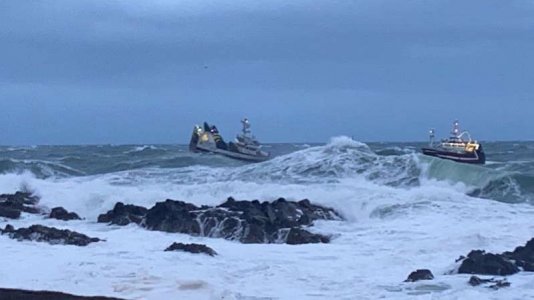Capt Lightning
Well-known Member
- Location
- Historic Buchan, Scotland
Not sure where to post this, but here goes.. Last night on BBC, the programme 'Saving lives at sea' featured a miraculous rescue that happened off Peterhead on the N.E of Scotland. Peterhead is a fishing port that hosts the largest white fish market in Europe. It also is a base for the support ships that supply the North sea oil rigs. This area is often subject to severe weather and In February, the trawler 'Opportunus' suffered engine failure and was under tow back to Peterhead when a force 8 gale sprang up. Before the trawler reached port, the tow line broke and the ship was swept towards the rocks near the harbour breakwater.

The Peterhead lifeboat was launched and despite mountainous seas, in an act of extreme bravery, managed to get a tow line to the stricken trawler and towed it to the safety of the harbour.... Picture shows the Opportunus (left) some 50 yards from the rocks. Another trawler stands by to help if needed. Waves were up to 30 feet peak to trough. Note that the lifeboat crews are mainly unpaid volunteers. The RNLI is not funded by government, but a charity that relies on donations and bequests.
So, how did there come to be a harbour, breakwater and a JAIL in Peterhead? Towards the end of the 1800's, the Royal navy was searching for a safe anchorage in N.E. Scotland. Peterhead would seem ideally located, except that there was no shelter from the North sea. The solution was simple, build a breakwater and pier. Problem.. that's going to cost a lot of money. We need it done cheaply.
Solution .. use convicts. Next problem... no jail. Solution.. build a jail. Fine, but how do we get the prisoners and materials to the harbour? Solution,, build a railway.
And so it happened. A prison was built and soon gained the reputation of Scotland's toughest jail. Prisoners were taken in special railway carriages to the harbour site, and watched over by armed guards while they built the pier and breakwater. Nobody escaped from the working parties, but apparently one prison missed the train and was found later walking back to the prison.
The Jail was closed in 2013 and has now become a popular visitor attraction. It also houses a lifeboat museum which features a restored lifeboat that saw action from 1939 till 1969.

The Peterhead lifeboat was launched and despite mountainous seas, in an act of extreme bravery, managed to get a tow line to the stricken trawler and towed it to the safety of the harbour.... Picture shows the Opportunus (left) some 50 yards from the rocks. Another trawler stands by to help if needed. Waves were up to 30 feet peak to trough. Note that the lifeboat crews are mainly unpaid volunteers. The RNLI is not funded by government, but a charity that relies on donations and bequests.
So, how did there come to be a harbour, breakwater and a JAIL in Peterhead? Towards the end of the 1800's, the Royal navy was searching for a safe anchorage in N.E. Scotland. Peterhead would seem ideally located, except that there was no shelter from the North sea. The solution was simple, build a breakwater and pier. Problem.. that's going to cost a lot of money. We need it done cheaply.
Solution .. use convicts. Next problem... no jail. Solution.. build a jail. Fine, but how do we get the prisoners and materials to the harbour? Solution,, build a railway.
And so it happened. A prison was built and soon gained the reputation of Scotland's toughest jail. Prisoners were taken in special railway carriages to the harbour site, and watched over by armed guards while they built the pier and breakwater. Nobody escaped from the working parties, but apparently one prison missed the train and was found later walking back to the prison.
The Jail was closed in 2013 and has now become a popular visitor attraction. It also houses a lifeboat museum which features a restored lifeboat that saw action from 1939 till 1969.

